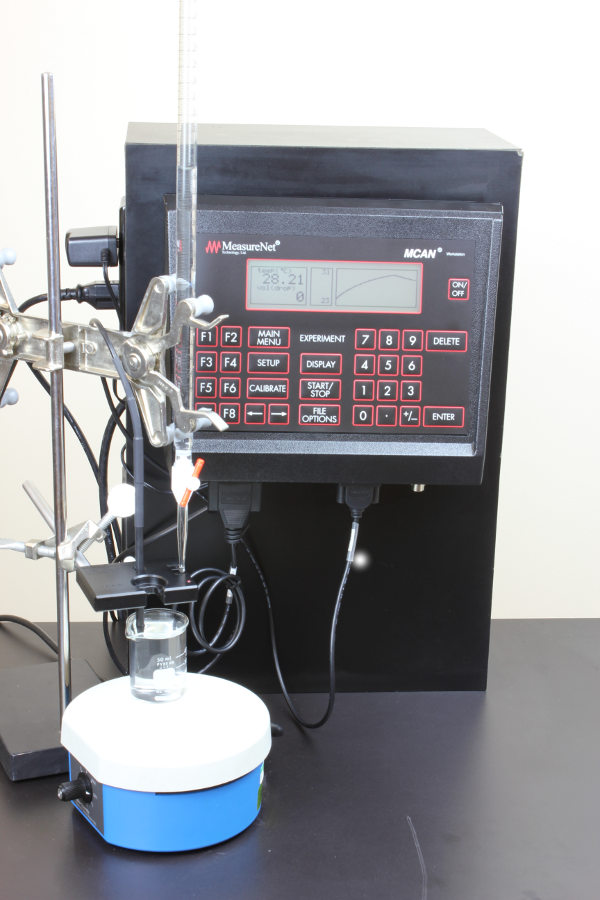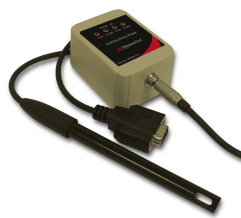MeasureNet has added some new features to our LabKonnect™ data storage site and PC software that provide you and your students with even greater flexibility than before.
- Automatic Data Files Graphing
- Online Lab Report Storage/Submission
- Extended Experiments with Remote Monitoring
Automatic Data Files Graphing
With the rollout of the new LabKonnect features, we decided to make it easier to get a quick idea of your data sets. Users can graph any data set uploaded through the MeasureNet Lab PC software right on the LabKonnect™ site.

Online Lab Report Storage/Submission
MeasureNet LabKonnect now allows students to upload their lab reports and store them on the cloud. Instructors can download the lab reports, grade them, and then upload the graded lab report to the student's account for instant feedback with no wasted paper.

(Lab Report View)

(Lab Report Upload)
Extended Experiments with Remote Monitoring
One of MeasureNet's most exciting new features is the ability to conduct extended length experiments and remotely monitor them from the web. If you have an experiment with a slow reaction that needs to be monitored over several days, you can go home and have fun while still collecting your data. MeasureNet will even send you a text message if your experiment goes out of bounds. That way you can come in and fix your setup without losing days worth of valuable data.
You can set up your alert conditions online, and then start the extended experiment with the Lab PC Software. After that, you just let your experiment run until you choose to stop it.
This capability is ideal for research projects that require the monitoring of experiments that run for days or weeks. The William Heineman research group at the University of Cincinnati has been using this feature for a number of their research projects.

(Setting Up Extended Experiment in Lab PC Software)
If you want to check up on your data and see how it's trending, you can log in and graph or download the data that has been collected so far. You can also leave comments on each of the extended experiment files in case you want to do multiple runs.

(View and Graph Extended Experiment Files)

(Mange Extended Experiment Files)
The folks here at MeasureNet have been hard at work integrating new probes into our system and creating new experiments. In this blog entry we'll be introducing the following new experiments and probes:
- Thermometric Titrations
- Conductivity Probe & Experiment Options
- Colorimetric Titration Hardware
Thermometric Titrations
The newest software integrates the drop counter and temperature probe and now has the capability to conduct experiments with Temperature vs Drops. This allows users to conduct Thermometric Titrations.

Conductivity Probe & Experiment Options
MeasureNet now offers a 4 range high resolution conductivity probe. MeasureNet provides users the ability to conduct experiments with Conductivity vs Time and use the drop counter for Conductivity vs Volume for Conductometric Titrations.

Colorimetric Titration Hardware
MeasureNet systems now have the ability to conduct colorimetric, Fluorometric, turbidometric and chemiluminescent titration experiments. When ordering colorimeters, customers can specify if they would like them customized for photometric titrations. The kit includes a colorimeter, a base stand, a pump with power supply, and custom-made flow cell that pair with the MeasureNet colorimeter and drop counter.

The MeasureNet MCAN® (Multi-functional Chemical Analysis Network) system consists of up to fifteen measurement workstations networked together and managed by a single MCAN® Controller and PC. Each Workstation has two +/- 2.5v analog input channels and one high-speed serial communication channel. The analog inputs are sampled by a two channel high-resolution 24-bit Sigma-Delta A/D. Sigma-Delta converters are designed for direct connection to sensors with low signal levels. The built-in signal conditioning and noise reduction of Sigma-Delta data converters makes them ideal for the low level noisy signals often found in potentiometric measurements of high impedance sensors like pH, ISE and other electrochemical sensors. The high-speed serial channel is for sensors with digital outputs.
The MCAN® workstation measurements are displayed in real-time on the workstation LCD and/or streamed in real-time to MeasureNet's LabKonnect cloud server for storage. Data collected at the workstations can be stored locally on the system PC and/or in cloud data storage accounts. Cloud data can also be monitored in real-time from any internet connected device - computer, tablet or smart phone, allowing the researcher to follow the progress from virtually anywhere while running experiments for extended time periods. LabKonnect will also alert the researcher via text message if something has gone wrong. The researcher specifies a range; the system notifies team members if measurements go beyond that range. Researchers no longer need to spend valuable time and resources babysitting experiments.
Comparison of the Effects of Biofouling on Voltammetric and Potentiometric Measurements
Kuhlmann, J., Dzugan, L. C. and Heineman, W. R. (2012), Comparison of the Effects of Biofouling on Voltammetric and Potentiometric Measurements. Electroanalysis, 24: 1732–1738. doi: 10.1002/elan.201200194
Abstract
Biofouling of sensors is a common problem when measuring biological samples. The adherence of proteins and biomolecules, called hemostasis, is the first of four steps that lead to biofouling and eventually a foreign body response. This typically occurs within the first hours after the exposure of the biosensor to a biological sample. The purpose of this study was to assess the effect of this initial step of biofouling on cyclic voltammetry and potentiometric measurements. The results show that biofouling occurred rapidly within minutes and strongly affected cyclic voltammetry measurements, while were minimally affected even after 24 hours.

WVXU Podcast link by Ann Thompson: Focus on Technology: Bugs Cleaning Wastewater
Cincinnati scientists are engineering special bugs that will clean wastewater and create energy. Ann Thompson takes you into the lab where this is happening in Focus on Technology.
By Ann Thompson
MeasureNet Research Applications
MeasureNet is renowned for putting cutting-edge technology into the hands of students but MeasureNet may someday be famous for helping scientists find new and innovative ways for dealing with the world’s most difficult problems.
The technology provided by MeasureNet combines a high-resolution measurement workstation with their LabKonnect cloud-based software to create a system that allows researchers to monitor their experiments from anywhere. Researchers access information from the cloud, important in experiments lasting for a week or longer.
LabKonnect will also alert the researcher via text message if something has gone wrong. The researcher specifies a range; the system notifies team members if data goes beyond that range. Scientists no longer spend valuable time and resources babysitting experiments.
This technology was put through its paces recently, when MeasureNet teamed with Dr. Dan Hassett, who creates special bugs that will clean wastewater and create energy. Hassett, molecular genetics professor at the University of Cincinnati, thinks he has found a way to convert sewage into clean water and energy.
Wastewater has stored up energy in the form of pollutants. Hassett is developing bacterial robots, or “bactobots,” that break down these pollutants and release the energy. Sewage treatment plants become biological fuel cells that produce both clean water and energy.
The bactobots are tiny, only about three microns long, but they generate about 400 milivolts with fluctuations as high as 700 milivolts as they clean the water. Hassett increases the amount of power a bactobot can generate through a series of genetic mutations. Measuring the output of these miniscule bacteria is a big job, and that’s where MeasureNet steps in.
MeasureNet helped Dr. Hassett monitor the voltage and current output of biological fuel cells. Typically, the ouput voltage fluctuates and over the course of four days. Thanks to the sensitive measuring equipment and cloud capabilities provided by MeasureNet technology, Hassett found the existence of a second particular bacterium actually increased output over those four days.
While the output from a single bactobot is small, the impact of these biological fuel cells could break one of humanity’s most vexing vicious cycles. Wastewater treatment plants are the single largest consumer of energy, and the second largest user of water is energy production. Introducing a bacteria that would simultaneously clean water and produce energy would be monumental.
MeasureNet is at the forefront of hands-on laboratory technology, both in the classroom and in the research lab. Like technology itself, MeasureNet continuously develops new ways to enhance the lives and learning of students, scientists and everyday people.

Researchers expand capabilities of miniature analyzer for complex samples
(PhysOrg.com) -- It’s not often that someone can claim that going from a positive to a negative is a step forward, but that’s the case for a team of scientists from the National Institute of Standards and Technology (NIST) and private industry. In a recent paper,* the group significantly extended the reach of their novel microfluidic system for analyzing the chemical components of complex samples. The new work shows how the system, meant to analyze real-world, crude mixtures such as dirt or whole blood, can work for negatively charged components as well as it has in the past for positively charged ones.